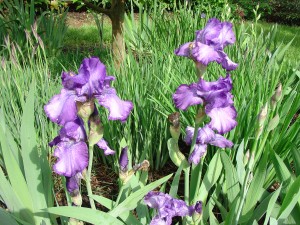Most gardeners plant tall bearded iris from late August through October to insure good root development before winter sets in. Spring planting is another option as iris may be purchased in containers. Bare root rhizomes need to soak overnight in water before planting. Bearded irises prefer a sunny location and a slightly acidic well-drained soil. Work in plenty of compost into the garden soil prior to planting and lightly mulch iris 1-2 inches after planting. Irrigate the bed every 5-7 days if natural precipitation is light; once the first new center leaves appear, iris rhizome(s) have rooted.
Remove the bloom stalks after flowering and cut the foliage down to 3-4 inches in late fall. Irises need dividing every 3-4 years to prevent overcrowding. Right after Labor Day is a fine time to divide and/or transplant in the Southern Appalachian region (USDA zones 6 and 7). Avoid the stressful hot days of summer. Plant each rhizome shallow, barely beneath the surface of the soil.
Irises grow best in raised beds, particularly if the garden soil is heavy clay. Add superphosphate (0-45-0) to the soil before planting. A good low-nitrogen fertilizer such as 6-12-12 can be used early in the spring. Do not mulch or overwater.
Tall bearded rises are susceptible to a number of disease and pest issues. Remove and discard (do not compost) all dead leaves and bloom stalks by late fall so not to overwinter various diseases and pests.
In the spring treat leaf spot diseases with Daconil™ fungicide. To manage iris borers, aphids and beetle grubs, choose a systemic insecticide like Merit™ (imidacloprid).


 Posted in
Posted in 
